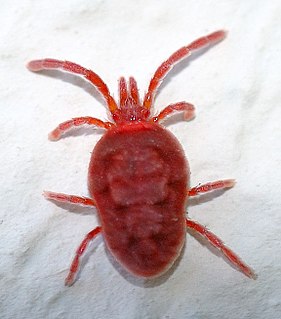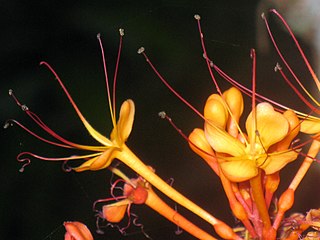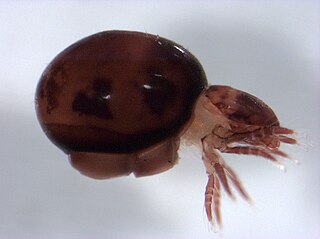
A lichen is a composite organism that arises from algae or cyanobacteria living among filaments of multiple fungi species in a mutualistic relationship. Lichens have properties different from those of their component organisms. Lichens come in many colors, sizes, and forms and are sometimes plant-like, but lichens are not plants. Lichens may have tiny, leafless branches (fruticose), flat leaf-like structures (foliose), flakes that lie on the surface like peeling paint (crustose), a powder-like appearance (leprose), or other growth forms.

Mites are small arachnids.

Lichen planus (LP) is a chronic inflammatory and immune-mediated disease that affects the skin, nails, hair, and mucous membranes. It is not an actual lichen, and is only named that because it looks like one. It is characterized by polygonal, flat-topped, violaceous papules and plaques with overlying, reticulated, fine white scale, commonly affecting dorsal hands, flexural wrists and forearms, trunk, anterior lower legs and oral mucosa. Although there is a broad clinical range of LP manifestations, the skin and oral cavity remain as the major sites of involvement. The cause is unknown, but it is thought to be the result of an autoimmune process with an unknown initial trigger. There is no cure, but many different medications and procedures have been used in efforts to control the symptoms.

Usnea is a genus of mostly pale grayish-green fruticose lichens that grow like leafless mini-shrubs or tassels anchored on bark or twigs. The genus is in the family Parmeliaceae. It grows all over the world. Members of the genus are commonly called old man's beard, or beard lichen.
The long-tailed mouse is a native Australian mammal in the Order Rodentia and the Family Muridae. It is found only on the island of Tasmania. The long-tailed mouse is an omnivore that feeds on insects and a range of plants. It is found in forested areas, particularly in sub-alpine scree, and may live in burrows.

Xanthoria parietina is a foliose, or leafy, lichen. It has wide distribution, and many common names such as common orange lichen, yellow scale, maritime sunburst lichen and shore lichen. It can be found near the shore on rocks or walls, and also on inland rocks, walls, or tree bark. It was chosen as a model organism for genomic sequencing by the US Department of Energy Joint Genome Institute (JGI).

Saraca L. is a genus of flowering plants in the family Fabaceae of about 20 plant species of trees native to the lands from India, China and Ceylon to Malaysia and Sulawesi.

Oribatida, also known as oribatid mites, moss mites or beetle mites, are an order of mites, in the "chewing Acariformes" clade Sarcoptiformes. They range in size from 0.2 to 1.4 millimetres. There are currently 12,000 species that have been identified, but researchers estimate that there may anywhere from 60,000 to 120,000 total species. Oribatid mites are by far the most prevalent of all arthropods in forest soils, and are essential for breaking down organic detritus and distributing fungi.
Trebouxia is a unicellular green alga. It is a photosynthetic organism that can exist in almost all habitats found in polar, tropical, and temperate regions. It can either exist in a symbiotic relationship with fungi in the form of lichen or it can survive independently as a free-living organism alone or in colonies. Trebouxia is the most common photobiont in extant lichens. It is a primary producer of marine, freshwater and terrestrial ecosystems. It uses carotenoids and chlorophyll a and b to harvest energy from the sun and provide nutrients to various animals and insects.

Bryoria fremontii is a dark brown, hair-like lichen that grows hanging from trees in western North America, and northern Europe and Asia. It grows abundantly in some areas, and is an important traditional food for a few First Nations in North America.

Lobaria pulmonaria is a large epiphytic lichen consisting of an ascomycete fungus and a green algal partner living together in a symbiotic relationship with a cyanobacterium—a symbiosis involving members of three kingdoms of organisms. Commonly known by various names like tree lungwort, lung lichen, lung moss, lungwort lichen, oak lungs or oak lungwort, it is sensitive to air pollution and is also harmed by habitat loss and changes in forestry practices. Its population has declined across Europe and L. pulmonaria is considered endangered in many lowland areas. The species has a history of use in herbal medicines, and recent research has corroborated some medicinal properties of lichen extracts.
Vermilacinia, a genus of lichenized fungi in the family Ramalinaceae, is a yellow-green fruticose type of lichen with about 30 species that grow on rocks, trees, and soil within the fog zone along the Pacific Coast of North America and South America. The genus name refers to the thallus being divided into narrow worm-like (vermis) branches (lacinia);the latter part of the name (lacinia) generally applied in descriptions and taxonomic keys such as exemplified in a key to Sonoran Desert species of Ramalina.

Hypogymnia is a genus of foliose lichens in the family Parmeliaceae. They are commonly known as tube lichens, bone lichens, or pillow lichens. Most species lack rhizines that are otherwise common in members of the Parmeliaceae, and have swollen lobes that are usually hollow. The lichens usually grow on the bark and wood of coniferous trees.

Punctelia is a genus of foliose lichens belonging to the family Parmeliaceae. They are commonly known as speckled shield lichens or speckleback lichens. Characteristics that define this genus include the presence of hook-like to thread-like conidia, point-like pseudocyphellae, and simple rhizines. Punctelia lichens grow on bark, wood, and rocks. They are found in temperate to subtropical locations, and have centres of distribution in the Neotropics and Africa.
Rhodacaridae is a family of mites in the order Mesostigmata.
Robert Price Higgins is an American systematic invertebrate zoologist and ecologist, specializing in the unusual taxa of kinorhynchs and tardigrades.
John Walter Thomson Jr. (1913–2009) was a Scottish-born American botanist and lichenologist, sometimes referred to as the "Dean of North American Lichens".
Thomas Hawkes Nash III is an American lichenologist. His research is about the biology and ecology of lichens, and the effects of air pollution on plants and lichens. He is known as an authority on the family Parmeliaceae. During his long career at the Arizona State University, he helped develop the lichen herbarium into a world-class collection with over 100,000 specimens representing more than 5000 species. In 2010, the year of his retirement, he was awarded the Acharius Medal for lifetime achievements in lichenology, and the following year had a Festschrift published in his honor.

Punctelia rudecta, commonly known as the rough speckled shield or the speckleback lichen, is a North American species of foliose lichen in the family Parmeliaceae. This species can be readily identified by the light color of the thallus underside, the relatively large lobes at the edges of the thallus, and the tiny white pores present on the top of the thallus that are characteristic of the genus Punctelia. The lichen is quite common and widespread in the southeastern United States, although it also occurs in Canada and northern Mexico as well. The lichen usually grows on bark, and less commonly on shaded rocks. There are several lookalike Punctelia species; these can often be distinguished from P. rudecta by differences in distribution or in the nature of the reproductive structures present on the thallus.
Punctelia transtasmanica is a species of foliose lichen in the family Parmeliaceae. It was described as a new species in 2005 by Australian lichenologists John Alan Elix and Gintaras Kantvilas. The type was collected near the summit of South Sister in Tasmania, at an altitude of 800 m (2,600 ft). There it was found on Tasmanian pepperberry growing in wet scrub. The specific epithet refers to "the occurrence of this species along the eastern and western shores of the Tasman Sea". The lichen also occurs in Flinders Island, where it is locally common, and the North Island of New Zealand. Punctelia transtasmanica resembles P. borreri, and had historically been confused with that species. They can be distinguished by differences in chemical reactions to lichen spot tests.











